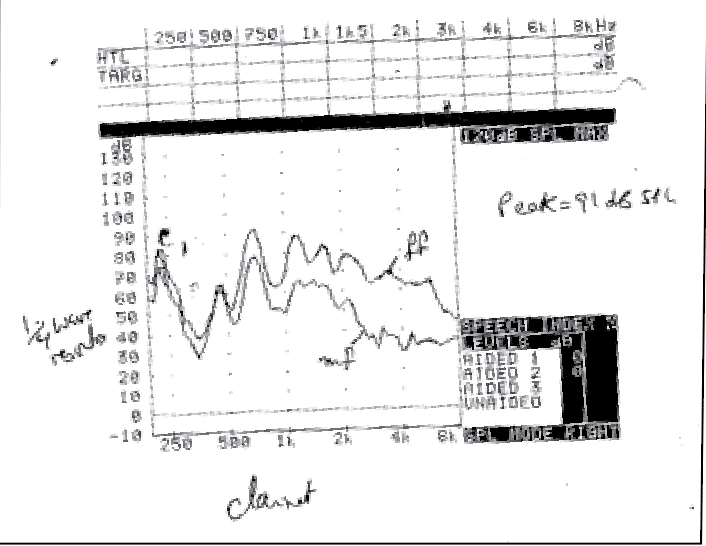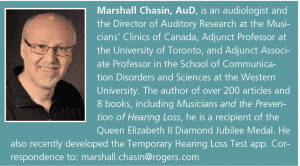Back to Basics | January 2018 Hearing Review
I am always surprised at how powerful a tool a clinical real-ear measurement device can be. Verification of a hearing aid (or hearing protection) fitting is an obvious usage, but it can be quite instructive about some general acoustic principles. The following case illustrates this.

Figure 1. Spectral analysis (using REM) of a clarinet playing middle C, with the playing level of the clarinet at mezzo forte (mf) and fortissimo (ff).
Using a real-ear measurement (REM) device, Figure 1 shows a spectral analysis of a clarinet playing the note C (at the middle of the piano keyboard). It was played at a medium level (mezzo forte, or mf) and then again at a very high level (fortissimo, or ff). The fundamental (or what musicians would call the tonic, or note name) increases very little—less than 10 dB in this case from medium to very loud—but the harmonics increase dramatically by 30-35 dB. And, of course, the spectral shape is quite different depending on whether the clarinet is played softly or at a high level.
The relative high-frequency increase as the playing level increases is true of all reeded woodwinds and can also be observed with the different members of the saxophone family. At high levels, the reed itself starts to spasm and distort creating extreme levels of “source vibration” or harmonic energy. This high-level distortion cue is a primary element in assisting the reeded woodwind player to ascertain their loudness level. Of course, well-experienced clarinet players tend to rely on their sense of pressure from their lungs, but a listener hears a loud clarinet quite differently from one that is played at a softer level. This is one of my favorite things about my clarinet—it has great dynamics.
If we were to use the same REM paradigm for brass or stringed instruments, the results would be quite different; the low-frequency fundamental and the higher frequency harmonic structure would all increase uniformly as the playing level increased from quiet (pp) to loud (ff). And, if we were to use this same technique for speech, the low-frequency sounds (sonorants) would increase dramatically in level as the speaking level increased, but the higher frequency consonants (obstruents) would not change at all—the exact opposite of the changes observed in reeded woodwinds.
However, the technique that we use for REM would give different results. While all commercially available REM devices should be able to demonstrate these spectral changes for music, this is not necessarily the case for speech.
Musical instruments are all characterized by a low-frequency fundamental (or tonic) and also by higher frequency harmonics—it is the exact frequency placement of the harmonics, as well as their relative amplitudes, that define a musical instrument as well as the quality of the instrument. Using a swept-frequency probe or any other technique (such as a Fast Fourier Transform, or FFT) are quite sufficient to demonstrate this.
Speech is an entirely different acoustic animal than music. Music is always concurrent; the low-frequency fundamental and higher frequency harmonics occur at the exact same time. Either a swept pure-tone or FFT form of analysis should be more than adequate for measuring music. Speech, however, is not concurrent; at any one point in time, speech is either low-frequency energy (sonorants) or high-frequency energy (obstruents), but never both. REM techniques that “assume” the stimulus is static, such as the articulation of a single sound like [s] as in “silly” over time, or music, can indeed be useful, but the moment one speech sound changes to another speech sound, a time-integrated spectral analysis technique such as an FFT, is required.
Whether the REM system uses a swept pure-tone and an associated bank of digital filters (eg, Audioscan) or an FFT (eg, Frye), these systems can be turned into spectral analysis devices and not just as verification devices for a hearing aid fitting. After having calibrated the system, one needs to disable the device’s loudspeaker and disable the reference microphone. Different manufacturers have different terminology, such as setting the stimulus level to “0 dB” or setting the stimulus level to “off.” Once this is done, the REM can be a very powerful tool that can be used for spectral analysis and teaching us about important acoustic principles.
Original citation for this article: Chasin M. Real-ear measurement is not just for verification. Hearing Review. 2018;25(1):10.






